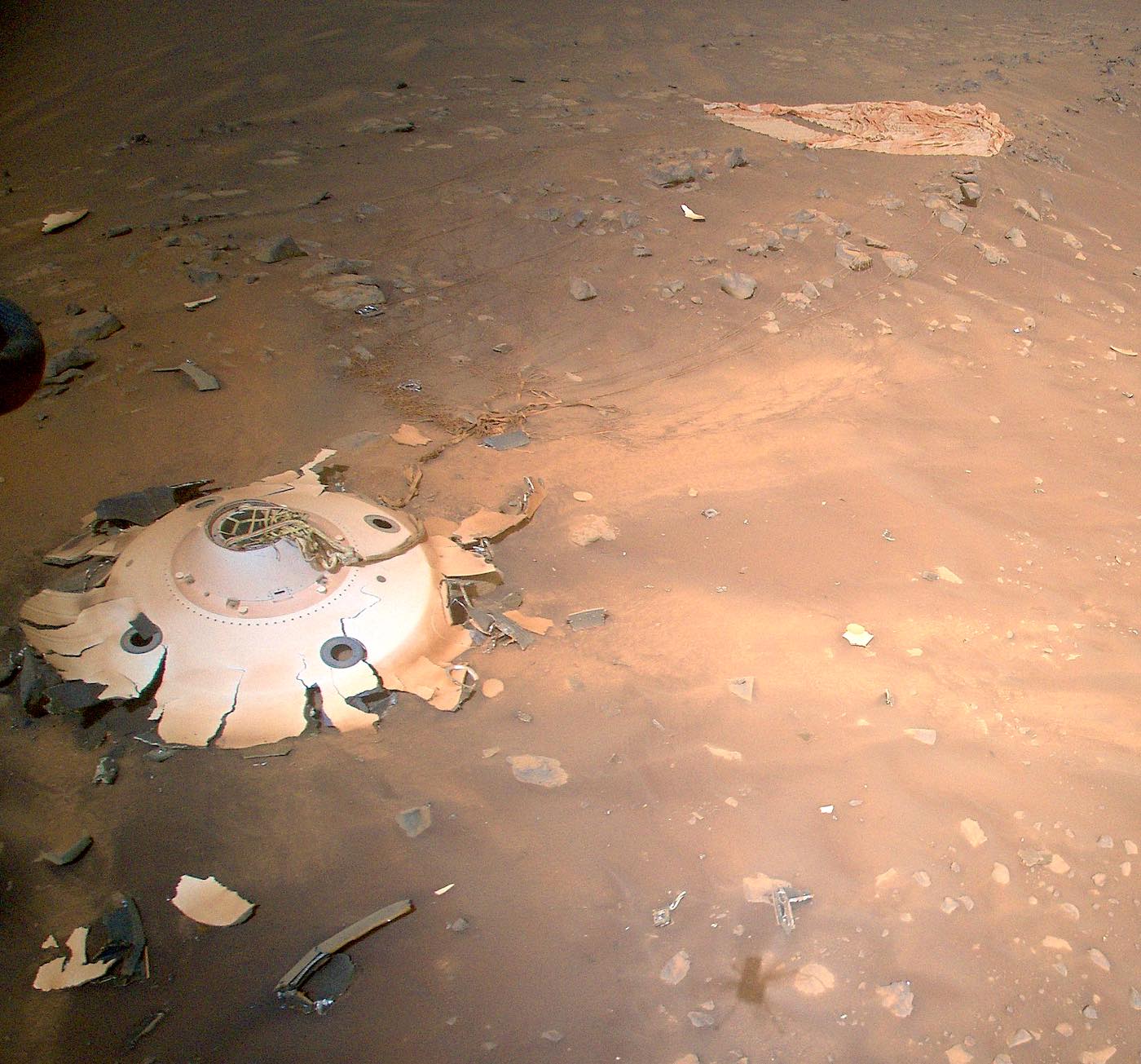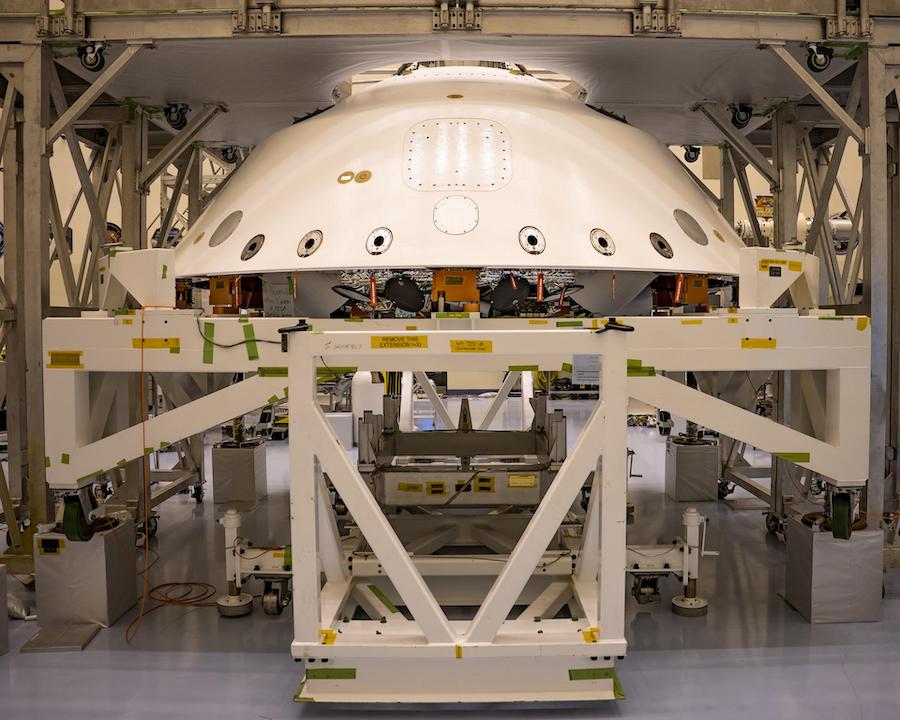
NASA’s flying drone on Mars has recorded aerial views of debris left behind from the landing of the Perseverance rover last year, showing remarkable details of the craft’s supersonic parachute and part of its aeroshell.
The robotic Ingenuity helicopter flew over the parachute and back shell April 19 after cameras on the Perseverance rover itself spotted the hardware from a distance. The rover will not be guided to take an up-close look at the hardware, but the Ingenuity helicopter captured 10 pictures of the chute and back shell from an altitude of about 26 feet (8 meters).
NASA engineers working on the Mars Sample Return program, which aims to bring Martian rock specimens back to Earth, requested the flyover by the Ingenuity helicopter. The 10 color images will allow engineers to examine the condition of the back shell and parachute, providing new insights into how they performed when the Perseverance rover arrived on Mars on Feb. 18, 2021.
“Perseverance had the best-documented Mars landing in history, with cameras showing everything from parachute inflation to touchdown,” said Ian Clark, an engineer at NASA’s Jet Propulsion Laboratory and former Perseverance systems engineer.
“But Ingenuity’s images offer a different vantage point,” said Clark, now in charge of the ascent portion of the Mars Sample Return mission. “If they either reinforce that our systems worked as we think they worked or provide even one dataset of engineering information we can use for Mars Sample Return planning, it will be amazing. And if not, the pictures are still phenomenal and inspiring.”
Ingenuity visited the wreckage on its 26th flight, which occurred on the one-year anniversary of the small helicopter’s first hop on the Red Planet. Ingenuity became the first aircraft to fly in the atmosphere of another planet. It was originally slated to fly five times as a technology demonstration experiment, but now NASA is using the helicopter as an aerial scout to assist the Perseverance rover with its science mission.
“NASA extended Ingenuity flight operations to perform pioneering flights such as this,” said Teddy Tzanetos, Ingenuity’s team lead at JPL. “Every time we’re airborne, Ingenuity covers new ground and offers a perspective no previous planetary mission could achieve. Mars Sample Return’s reconnaissance request is a perfect example of the utility of aerial platforms on Mars.”
Mars rovers have examined their leftover debris before. NASA’s Opportunity rover encountered its heat shield in 2005, about a year after landing on the Red Planet. But Ingenuity offered engineers a chance to inspect the landing hardware without sending the rover itself to look at it, allowing Perseverance to continue its scientific campaign.

The back shell was part of the structure that housed the Perseverance rover during the journey from Earth to Mars. The aeroshell shielded the robot from aerodynamic forces and heat as the spacecraft plunged into the Martian atmosphere at a velocity of nearly 12,500 mph (20,000 kilometers per hour).
The rover jettisoned the parachute and back shell about a minute before landing in Jezero Crater, a basin once covered in liquid water fed by a river flowing down from nearby highlands. The rover then slowed for landing with the help of a rocket pack, which lowered Perseverance to the surface of Mars on cables and bridles in a technologically complex method NASA calls the “sky crane.”
The mission’s supersonic parachute measured 70.5 feet (21.5 meters) wide when fully inflated. But the rarefied atmosphere on Mars meant the rover couldn’t slow for landing using aerodynamic braking alone, so the chute was jettisoned to free up the craft to finish the landing with its rocket-powered descent stage.
The back shell measured nearly 15 feet (4.5 meters) in diameter, and NASA said the debris impacted the Martian surface at about 78 mph (126 kilometers per hour).
“The back shell’s protective coating appears to have remained intact during Mars atmospheric entry,” NASA said. “Many of the 80 high-strength suspension lines connecting the backshell to the parachute are visible and also appear intact.”
The parts of the parachute visible to the Ingenuity helicopter appeared to show no signs of damage from the supersonic airflow it encountered during descent last year. NASA said engineers will spend several weeks analyzing the imagery before making any concrete conclusions.
The one-ton, plutonium-powered Perseverance rover is on a mission to collect samples for return to Earth, the first leg of the multi-launch Mars Sample Return program. NASA and the European Space Agency plan to send a send a series of spacecraft to Mars later this decade to fetch the samples gathered by Perseverance, launch them off of the Red Planet and into space, then bring the specimens back to Earth for analysis in sophisticated terrestrial labs.

The Ingenuity flight April 19 lasted 159 seconds and occurred around midday local time on Mars. The 4-pound (1.8-kilogram) rotorcraft accomplished several maneuvers to crisscross the area around the parachute and back shell, covering 1,181 feet (360 meters) in total.
In its 26 flights so far, Ingenuity has logged more than 49 minutes aloft and traveled 3.9 miles (6.2 kilometers), according to NASA.
“To get the shots we needed, Ingenuity did a lot of maneuvering, but we were confident because there was complicated maneuvering on flights 10, 12, and 13,” said Håvard Grip, chief pilot of Ingenuity at JPL. “Our landing spot set us up nicely to image an area of interest for the Perseverance science team on Flight 27, near ‘Séítah’ ridge.”
Ingenuity and Perseverance are now operating in a more rugged region in a dried-up river delta where water once flowed into Jezero Crater. The rover completed the first phase of its mission close to where it landed on the Red Planet last year, then drove across the Martian landscape to the new area of operations, covering about 3 miles (5 kilometers) in 31 days, the quickest traverse by any Mars rover in history.
Perseverance arrived at the delta region earlier this month. The rover will collect more rock samples there, and store them for eventual return to Earth. Scientists are eager to analyze the specimens in search for clues about the environment on Mars billions of years ago, when the planet was warmer, wetter, and could have harbored life.
Ingenuity will help mission planners determine which routes the rover should take to explore the fan-shaped delta.
Email the author.
Follow Stephen Clark on Twitter: @StephenClark1.
